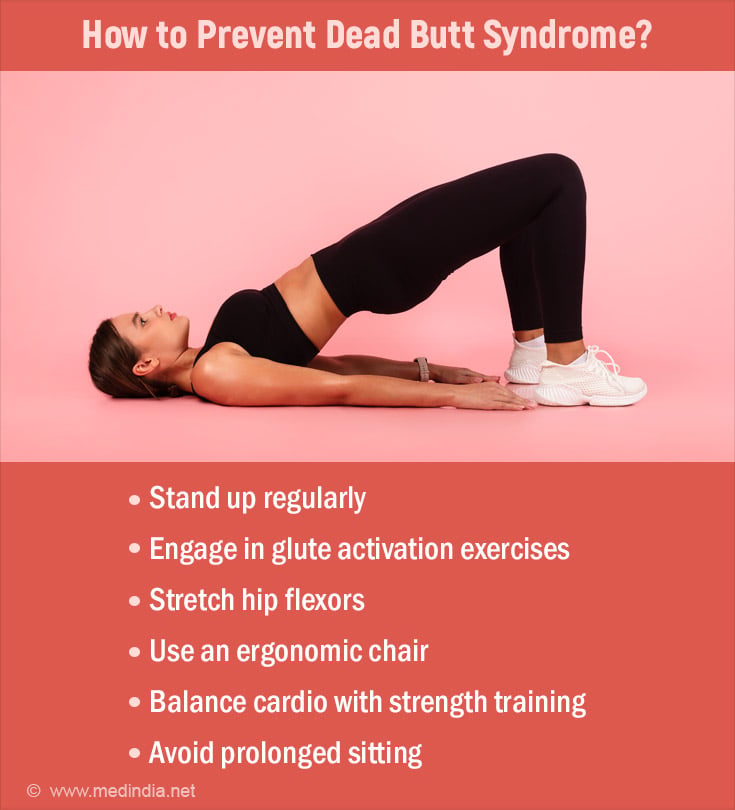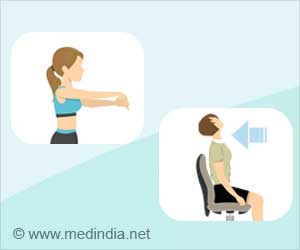- Deep Gluteal Syndrome: A Pain in the Buttock - (https://pubmed.ncbi.nlm.nih.gov/34099604/)
- Are You at Risk for Dead Butt Syndrome? - (https://www.michiganmedicine.org/health-lab/are-you-risk-dead-butt-syndrome)
About
Gluteal amnesia is a disease where muscles in the glutes, especially the gluteus medius, lose mobility or strength due to prolonged sitting, poor exercise, or repetitive actions. Consequences may lead to hip and lower back issues that influence the balance and coordination of the groups of muscles in several everyday movements and exercise routines(1✔ ✔Trusted Source
Deep Gluteal Syndrome: A Pain in the Buttock
Go to source).
What is Dead Butt Syndrome?
Dead Butt Syndrome (DBS), is the loss of proper gluteal muscle function, most notably failure to activate the gluteus medius. More colloquially known as inactive buttock syndrome.
Did You Know?
Prolonged sitting can cause Dead Butt Syndrome! #deadbuttsyndrome #gluteactivation #medindia
Symptoms of Dead Butt Syndrome
Early detection of DBS symptoms helps in the prevention of future discomfort:
- Hip pain and aches particularly on the outer hip side
- Lower back pain due to lack of support from weak glutes
- Knee pain due to muscular imbalance
- Glutes have weakened therefore causing legs to feel fatigued with strenuous exercise
- Weakness in the glute area not only leads to multiple leg areas hurting but at times makes individuals unbalanced, even with one leg.
Factors that Cause Dead Butt Syndrome
DBS often occurs through lifestyle or muscle inactivity. The main contributing factors are(2✔ ✔Trusted Source
Are You at Risk for Dead Butt Syndrome?
Go to source):
- Long duration of sitting reduces the innervations and flows of blood to the gluteus muscles
- Inactivity of the hip flexors, coupled with tight hip muscles, restricting the movement of the gluteus
- Repetitive repetition of the same actions such as running, cycling, etc without building strength in the muscles, therefore leading to an imbalance
- Faulty posture where improper sitting or standing postures negate the activation of the tissue of the gluteal muscle
- Lazy lifestyle, too few physical activities, weakening the glutes gradually,

How to Prevent Dead Butt Syndrome
Prevention of DBS is through an active lifestyle as well as a regular exercise routine that involves working out of the gluteal muscles:
- Stand up regularly and stretch if you sit for a long period
- Exercise and stretch your hip flexors
- Engage in gluteal activation exercises so that glutes are activated
- Sit on an ergonomic chair that will ensure good posture and less straining of the muscles
- Maintain the ideal balance of cardio with strength training by targeting those exercises that enhance the glutes together with surrounding muscles.
How to Treat Dead Butt Syndrome
Activation and strengthening of the glutes while simultaneously releasing the tightness in hip flexors.
- Get rest by not being on your feet for a longer time.
- Give an ice pack to reduce any swelling or pain.
- Physical therapy often times helps, with exercises designed to strengthen the gluteal muscles
- Massage therapy can relax the tissues and increase the blood flow
- Foam rolling of the glutes, hip flexors and hamstrings to try to alleviate tightness
- Gradual stretching can improve muscle flexibility and reduce pain.
Exercises for Dead Butt Syndrome
DBS is prevented and treated by regular exercise. Suggested exercises include:
- Glute bridges: Lie on your back with knees bent; now lift up your hips toward the ceiling, engaging the glutes.
- Clamshells: Lie on your side with knees bent; raise your top knee toward your chest while keeping your feet stuck together so that they do not touch the floor as you isolate your gluteus medius.
- Squats and lunges: Many exercises to build overall strength in the lower body require concentric engagement of the glutes, thighs, and hips.
- Hydrants: Kneel down and then straighten the one leg up to the side and maintain focus on squeezing glutes tight.
Specific exercises for dead butt syndrome such as hip thrusts and donkey kicks will wake up sleeping glutes.
Stretches for Dead Butt Syndrome
Stretch to reduce tension and improve the flexibility in the glutes:
- Hip flexor stretch: lunge forward with one leg, keeping the other knee on the ground, thereby stretching the hip flexors.
- Pigeon pose: An adaptation in yoga that allows opening of the hips for stretching the glutes as well as the lower back.
- Knee-to-chest stretch: lying on the back and bringing one knee toward your chest, an easy gluteal stretch.
- Figure-four stretch: Cross one ankle over the opposite knee and gently draw the other leg across your chest.
Dead Butt Syndrome and Running
DBS can ruin runners' lives, causing pain and limiting performance due to muscle imbalances. Runners should:
- Warm up with glute activation exercises before running
- Do strength training that focuses on the glutes to balance repetitive running motions
- Avoid overtraining and listen to your body's signals to prevent further damage
Dead Butt Syndrome and Cycling
Cyclists, who spend hours seated, are also at risk for DBS. To counteract this:
- Stand and stretch frequently throughout your ride
- Incorporate glute-focused exercises into your regimen as an antidote to the repetitive motion of pedaling
- Get your bike fitted so that you may adopt a neutral position; poor positioning causes or exacerbates muscle imbalances
Dead Butt Syndrome and Pregnancy
DBS also develops due to pregnancy because women change their posture and put extra stress on their glutes. A few helpful tips on how to deal with DBS during pregnancy include the following:
- Doing safe glute exercises, such as modified bridges and squats
- Avoiding sitting for extended periods to minimize strain on the glutes
- Supportive pillows while seated help keep good posture and reduce pressure on the hips.









